Paumas
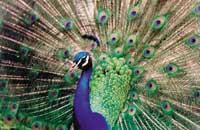
In this park, in addition to exotic and native trees, there is a trail of wildlife that separates the area of exotic birds introduced by man.
One of the species persecuted is the pauma, from the Pavo cristatus family of faisanids. The blue paumas are born from India and Sri Lanka, while the greens are born in Burma, Indotxina and Malaysia. The caused plumage mutations have given rise to the white paumas. The beauty of Paume has led many parks around the world to enjoy people.
Since the arrival of the first couple of children since 1977 from Barcelona, different families and blood have been added. Currently, there are 10 “parzoneros” who live freely, having learned to exploit the advantages offered by the park.
Sexual dimorphism
Although in most faisanids sexual dimorphism is evident, in the case of the paumas, the differences of plumage between males and females are enormous.
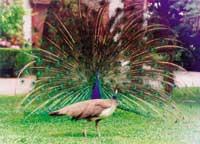
Adult males (we speak of the blue variety) have a length of 200-230 cm. The brooch, neck and head are discreet blue, forming in his head a bouquet of feathers shaped fan of the same color. They have a white line at the top and bottom of the eyes, extending from the pecking to the base of the fat. The fins are whitish brown, with interspersed stripes of grass and top feathers and orange rowing.
The long ozeladas feathers, so distinctive, do not correspond to the royal tail but to the false tail, which has its origin in the lower back.
These feathers can vary from a few cm to 170 cm, depending on their location and grouping. These beautiful frozen feathers change their color with the reflection of sunlight, alternating green, purple, blue and gold, among others. Paum has an average of 150 feathers of this type.
The scrub tail, when extended, becomes fan shape; the function of these feathers is decorative, but it is closely related to the reproductive procedure, as explained below.
The feathers of the royal tail are under the previous ones and are dark and hard. Its main function is to keep the feathers of the scrub tail when they are extended.
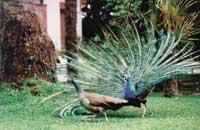
Females have an approximate length of 85 cm, usually brown, with greenish neck and whitish belly and face. The female vault is brown in size.
The feathers of the royal tail are shorter than the males, since they do not need to maintain the feathers of the decoration, since these are short and undeveloped. However, despite not having the same tendency as males to extend the tail, they are able to expand it and show it several times. With a simpler plumage, both in flight and between the branches of the trees, they are lighter and more skilful than the males.
Variety of colors
The Paumas came to Europe centuries ago. Since then they live and reproduce numerous parks.
Because the crossing between the different varieties produces fertile specimens, there are new ranges of colors. Already, XVII. At the end of the 20th century the white mutation arose.
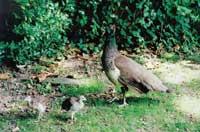
The crosses in the park have always been between blue and white specimens, since there are no more varieties.
If the blue colouring allele is associated with the white color in the Paumas, it is dominant and the phenotype of the plumage of the new specimens remains blue. However, in the genotype, in the subsequent group of factors, the white “hidden” allele is written, so the phenotype of the following generations may vary.
The chicks between homozygous blue and white paumas are blue, with maximum white rowing feathers. This new generation is heterozygous because it carries white and blue alleles.
The cluster of heterocygotics shows a result like this: 1/4 white, 1/2 blue heterozygous and 1/4 blue homozygous.
The offspring, although blue, between heterozygous and homozygous dominant, in which 1/2 is homozygous and 1/2 is heterozygous, happened in 1995 in the park what has not happened in 20 years: one in five in this type of crosses had white spaces. To birds with this type of coloring, the nursery farmers call with matas.
This event is named after mosaic genetic(1). The tissues of these animals contain at least two types of genetically different cells (different genotypes), or those that are composed of these tissues are those that have different phenotypes. The reason for this event, called mosaic, can have two origins:
- Mitotic recombination: In this
procedure the gene combination of diploid young cells does not correspond to the combination of primitive diploid cells along mitosis. - Loss of chromosomes in mitosis:
The two cells resulting from the mitotic division instead of A/a, only one is so. The carrier chromosome of the other dominant allele is somehow discarded forming the 0/a cell. Consequently, mosaic specimens are created with blue areas and white areas.
Whites are homozygous recitals and their breeding is white.
Reproductive period
Between April and July, during the reproductive period, the quiet life of the Paumas is transformed: the male screams of zeal constantly day and night.
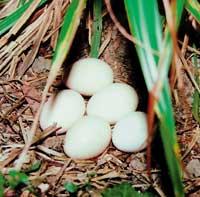
These cries resemble a long “euuuu, euuuu, euuuuu” that remind us of the sound of the trumpet. Although the shouts of zeal among the Paum are similar, their intonation, duration and capacity are, among others, characteristic.
They shout from the ground and from the higher branches of the trees.
Along with this trend (but only on the ground), the scrub tail and tail feathers form a fan of almost two meters. The show is unique: the neck and the blue head are at the center of the discreet green giant sphere, among the lumens that have the “eye” aspect of the camera.
At this time, the paumas are very vulnerable, reaching the highest degree of irritation: they cause the muscles of the back between the tail and the slabs of the scrub tail, while, with a shout, they cause the feathers of the wings to fall hitting the ground. He is now ready to fertilize.
If the female is ready (and so it happens in minorities), the male crushes; the coverage lasts a few seconds and the male beaten emits a special and short melody that can only be heard right now.
If the female is not ready, she does not, and although the male tries and jumps, there is no sexual intercourse.
Setting
Females, who like to place the nest on the ground, induce the soil with the legs making a small botxo. They need no nest, as there is no nesting. The laying lasts a few days, the eggs are put in intervals of one or two days. These are cream headlights. After laying the last egg, between 3 and 5, the female is sewn so that all births occur the same day. This is buried on the ground, always standing, until it becomes invisible. In these cases, in addition to the extremely effective camouflage, it is essential, since it is difficult to find and see people and wild animals. If the laying is lost, the female will make another 2 or 3 attempts.
From this moment on, the female will be glued; the female, once a day and at intervals of 15-20 minutes, leaves the nest to saturate her empty belly. The moment to leave the nest is usually very turbulent, with hunger and collision, flying at full speed and screaming. As it feeds it stops making a career, after tracking in a short time most food, it approaches the nest between the scrub, in silence.
Breeding
After about 25 days the chickens break the shell. The effort to get out of the egg lasts a few hours.
After birth, the family spends another day in the nest to dry the chickens' feather and strengthen the ducks. After this stage, the mother will leave the prairie and scrub of the park. These, in the early days, are not able to fly because they have not developed the feathers of their wings, so it is the most difficult and hard time of their life.
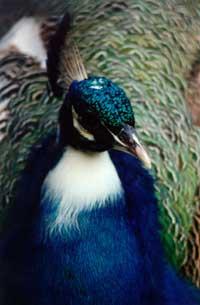
These chicks need almost at all times the heat so that any downpour or temperature can be deadly. The first 3-4 months have very slow growth, often slowing down and getting sick, leading to significant losses. In this phase of development is broadcast a single song, which resembles the singing of the show, sad and sad. If we reach 5-6 months, we can start talking about success, increasing the growth of young people and their movement and curiosity. The family will continue together until the next reproductive age.
The Paum reach the reigning maturity around 2 years. Meanwhile, females and young males resemble each other. Although the distribution of color in females is established from small, the male is longer and more complex. The young males present a separation of colors of the females, although they have the most bluish neck and sawn back. When females are willing to fall asleep in the 2nd year, males still have young plumage. However, they do fiery reproductive exposures and are willing to fertilize. With the change of pen by July-August of this second year, adult males will be able to show for the first time the plumage of adults. Because the procedure of growth of the flaps of the bushtail lasts a few months, until the 3rd spring of his life will not arrive with brightness to the plumage.
Feeding
The Paumas have a varied diet: seeds, citrus, grains, fresh sprouts of meadows, insects, etc. Sometimes, when they get caught by a worm or small lizard, they start running around to get the “prize.”
The little ones also eat the buds, the crushed grain and the insects nimiños.
In addition to this diet, they eat at ease what the human being offers: bread, popcorn, lettuce…
Lifestyle and customs
The Paumas have an excellent physical capacity, are good runners and their ability to fly is incredible: although the males are between 200 and 230 cm long, they fly with great skill in the face of any danger, simultaneously emitting a strong and long cry of alarm. Through this method, the other clowns, despite their remoteness, know the state of the alarm and prepare to undertake the getaway.
Paume likes to sleep on tall trees and are faithful to his tree. They often choose branches that extend over rivers and/or ponds. Males leave these trees during the breeding season by selecting other trees to shout.
Both in July and August suffer a change of plumage, so both decorative fins and other feathers fall into view the true dark tail. In the first months of winter, the development of decorative plumage will be evident and, for spring, they will have a wonderful appearance that has become so popular for everyone.
Opinion
The Pauma is a species of distant origin. Through ancient writings we know that 2000 ago human beings continued to grow. In Europe we carried with us more centuries than imagined that Roman emperors ate on special occasions. They currently reside in parks in several cities. The Paumas are not fully consolidated with the environment, since the supplementary food of the human being is fundamental. However, good adaptability to the place is appreciated.
If the species had an exaggerated reproduction, and this is not our case, it would not have the opportunity to spread because the physical reality of the city prevents it, for example, the park Cristina Enea is a park condemned to be surrounded by houses in the immediate future. Taking into account this basic premise, this type of park, in which in addition to the local offers the opportunity to meet other fascinating creatures, contribute to the expansion of the urban universe, resulting enriching.
The results speak
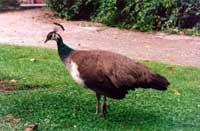
Clarified this specific exception, the paumas and other species of the Park of Cristina Enea have their difficulties: due to the excess of clearing that is done in the scrub, there are less and less hiding places, which causes some reproductive attempts. The grapefruits, one of the most skilful and predatory mammals in our forests, eat and disperse the eggs of many nests leaving clues in the park: empty and perforated shells. The stability of these animals in an urban park reflects the many resources of the area. We must not forget that the garduña has evolved for this and only fulfills its function.
Some citizens (minority but truly harmful) come too close to the nests, driving away the female and thus preventing the setting. Add to this the theft of eggs.
The floods of June 1, 1997 directly affected the death of a female, from 6 to 5 females. Females, if laying fails, can make survival attempts. With average estimates, between 50 and 60 eggs were burned in 1997. Of them, only 2 chickens have been born and, surprisingly, this nest has been in a small but quiet area of the school near the park, where the female has had to make flights of about 500 meters each day in search of food.
The average growth rate of these years has been very low: Slow growth rate between 1977-1986. Between 1987 and 1994 failures were predominantly and significantly reduced. At the end of the last year four new heads appeared, but one died by a stone. The year 1995 was more successful, leaving five out of seven. This group was added a year later and in 1997 the growth rate has been zero: two casualties and two births. If we take into account the loss of February this year we are heading for a negative rate of growth, but we must not forget that the results of this year's reproductive era are for the time being unpredictable.
These results will not change until the appropriate areas for the reproduction and education of all citizens are consolidated. Meanwhile, here are the 10 paumas of Cristina Enea Park, always perverse, fast and healthy.
In short, the life of the Paumas of San Sebastian is like this: sometimes fascinating, sometimes regrettable and always surprising.





